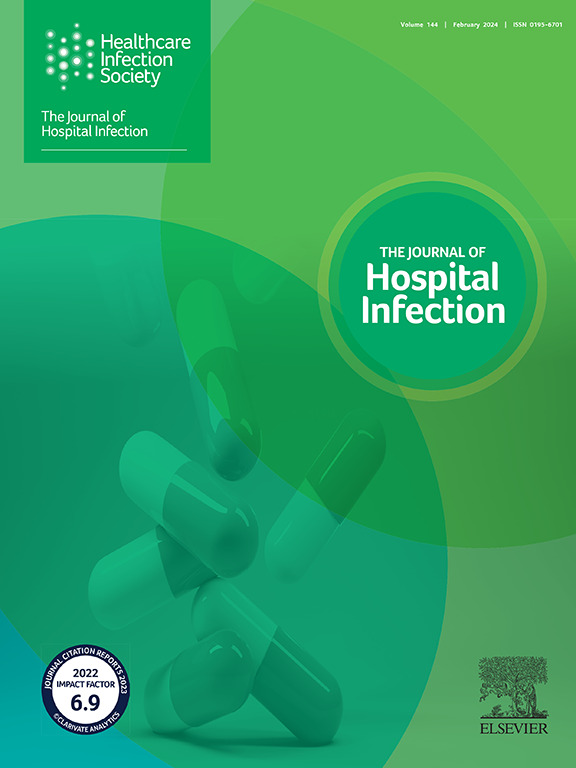Nosocomial bloodstream infection in critically ill patients: is extracorporeal membrane oxygenation a relevant factor?
IF 3.9
3区 医学
Q1 INFECTIOUS DISEASES
引用次数: 0
Abstract
Background
Nosocomial bloodstream infection (BSI) in critically ill patients can cause clinical deterioration, prolong intensive care unit (ICU) stays, and increase mortality risk. Extracorporeal membrane oxygenation support (ECMO) is a known risk factor for BSI, and infections in these patients are assumed to have a worse prognosis.
Aim
To compare risk factors for BSI between ECMO and non-ECMO patients.
Methods
A three-year prospective observational study was conducted in a 24-bed medical ICU. Consecutive nosocomial BSI episodes were recorded, and BSIs in mechanically ventilated patients were analysed based on ECMO treatment status.
Findings
A total of 98 BSI episodes were included: 30 (30.6%) in ECMO and 68 (69.3%) in non-ECMO patients. The total number of ECMO patients during the study period was 110, with a bacteraemia rate of 27.7% (20.26 episodes per 1000 treatment-days). In non-ECMO patients, the BSI rate was 7.9% (P < 0.001). ECMO patients were younger and had fewer comorbidities. BSI type and aetiology were similar between groups, but severity was higher in ECMO patients. Although multidrug-resistant micro-organisms were more frequent in ECMO patients, the appropriate treatment rate was similar. ICU mortality was 66.6% in ECMO patients and 30.8% in non-ECMO patients (P < 0.001). However, continuous renal replacement therapy (odds ratio (OR): 3.67), Sepsis Organ Failure Assessment score (OR: 1.54), and COVID-19 diagnosis (OR: 1.54) were the only independent risk factors associated with mortality in BSI patients.
Conclusion
Although BSI was more frequent and severe in ECMO patients, ECMO support was not independently related to mortality in patients with healthcare-associated BSI.
危重病人院内血流感染:体外膜氧合是一个相关因素吗?
背景:危重患者院内血流感染(bsi)可导致临床恶化,延长重症监护病房(ICU)住院时间,并增加死亡风险。体外膜氧合支持(ECMO)是已知的BSI危险因素,这些患者的感染被认为预后较差。然而,尚无ECMO与非ECMO患者的比较研究。方法:在24张床位的内科ICU进行为期3年的前瞻性观察研究。记录连续的院内bsi发作,并根据ECMO治疗情况分析机械通气患者的bsi。结果:共纳入98例BSI发作:ECMO患者30例(30.6%),非ECMO患者68例(69.3%)。研究期间ECMO患者总数为110例,菌血症发生率为27.7%(每1000治疗日20.26次)。在非ECMO患者中,BSI发生率为7.9%。结论:尽管在ECMO患者中BSI更为频繁和严重,但ECMO支持与医疗保健相关BSI患者的死亡率并没有独立相关。
本文章由计算机程序翻译,如有差异,请以英文原文为准。
求助全文
约1分钟内获得全文
求助全文
来源期刊

Journal of Hospital Infection
医学-传染病学
CiteScore
12.70
自引率
5.80%
发文量
271
审稿时长
19 days
期刊介绍:
The Journal of Hospital Infection is the editorially independent scientific publication of the Healthcare Infection Society. The aim of the Journal is to publish high quality research and information relating to infection prevention and control that is relevant to an international audience.
The Journal welcomes submissions that relate to all aspects of infection prevention and control in healthcare settings. This includes submissions that:
provide new insight into the epidemiology, surveillance, or prevention and control of healthcare-associated infections and antimicrobial resistance in healthcare settings;
provide new insight into cleaning, disinfection and decontamination;
provide new insight into the design of healthcare premises;
describe novel aspects of outbreaks of infection;
throw light on techniques for effective antimicrobial stewardship;
describe novel techniques (laboratory-based or point of care) for the detection of infection or antimicrobial resistance in the healthcare setting, particularly if these can be used to facilitate infection prevention and control;
improve understanding of the motivations of safe healthcare behaviour, or describe techniques for achieving behavioural and cultural change;
improve understanding of the use of IT systems in infection surveillance and prevention and control.
 求助内容:
求助内容: 应助结果提醒方式:
应助结果提醒方式:


